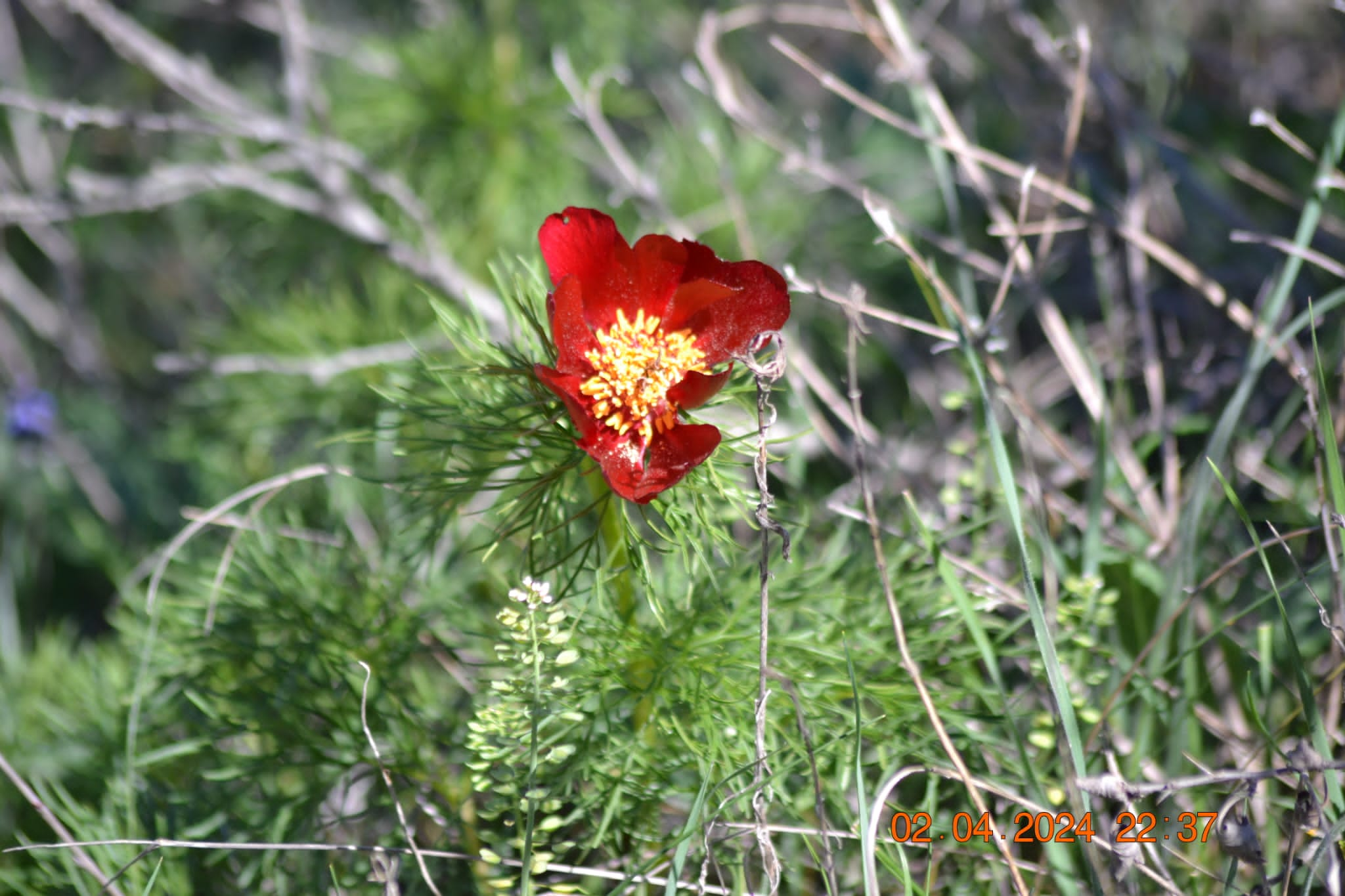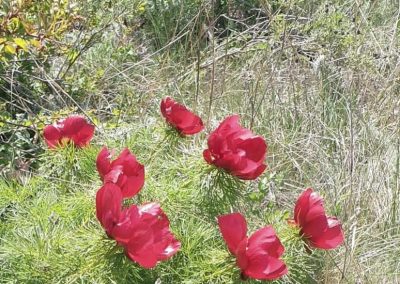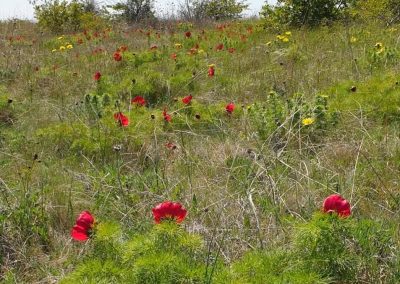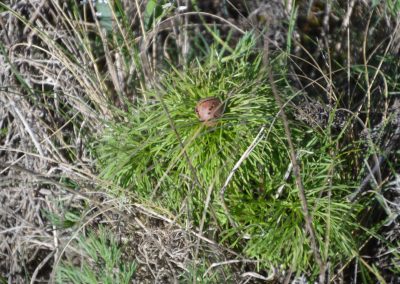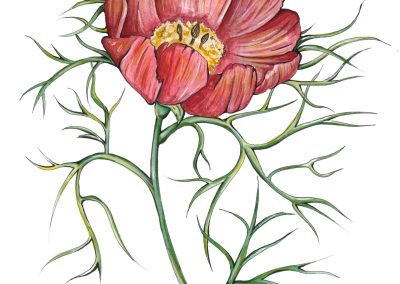Paeonia tenuifolia
Scientific description
Paeonia tenuifolia – Steppe Peony / Fernleaf Peony
Taxon: Angiospermatophyta (Magnoliophyta)
Class: Dicotyledonatae (Magnoliatae)
Subclass: Dilleniidae
Order: Dilleniales
Family: Paeoniaceae
Origin: Caucasian and Black Sea coast
Common name: Steppe Peony / Fernleaf Peony
Description:
Perennial, herbaceous, endemic plant, 70–90 cm. Roots fibrous, fasciculate, oblong-elliptic tubers. Stem glabrous, erect, cylindrical, slightly branched, up to 60 cm. Leaves long-petiolate, pinnately dissected, linear segments alternately arranged. Flowers red-purple, cup-shaped, solitary on top of glabrous peduncles, 6–8 petals, yellow stamens, fragrant. Blooms late spring–early summer.
Propagation: By seed at physiological maturity or by dividing tufts.
Ecology:
Sunny meadows from steppe to hills, in Dobrogea, Muntenia, southern Moldova. Prefers sunny areas with clay-sandy soil, moderate humidity.
Use:
Decorative, planted alone or in groups in parks/gardens. Medicinal: toothaches, headaches, sexual dysfunctions.
Threat:
National flower of Romania since October 26, 2022. Vulnerable/rare plant.
Paeonia tenuifolia – bujorul de stepă
Încrengătura: Angiospermatophyta (Magnoliophyta)
Clasa: Dicotyledonatae (Magnoliatae)
Subclasa: Dilleniidae
Ordinul: Dilleniales
Familia: Paeonaceae
Origine: Caucaz și coasta Mării Negre
Denumire populară: bujorul de stepă
Descrierea:
Plantă perenă, erbacee, endemică, 70–90 cm. Rădăcini fibroase, fasciculate, tuberculi oblong-eliptici. Tulpina glabră, erectă, cilindrică, ușor ramificată, până la 60 cm. Frunze lung pețiolate, penat-sectate, segmente liniare alternative. Florile roșii-purpurii, cupă, solitare pe pedunculi glabri, 6–8 petale, stamine galbene, parfumate. Înflorește primăvară târziu–început vară.
Înmulțire: Prin sămânță la maturitate fiziologică sau divizarea tufelor.
Ecologia:
Pajiști însorite din stepă până la dealuri, în Dobrogea, Muntenia, sudul Moldovei. Preferă zone însorite, sol argilo-nisipos, umiditate moderată.
Utilizare:
Plantă decorativă, singură sau în grupuri în parcuri/grădini. Medicinal: dureri de dinți, de cap, disfuncții sexuale.
Pericol:
Floarea națională a României din 26 octombrie 2022. Plantă vulnerabilă/rară.
Paeonia tenuifolia – Παιώνια της Στέπας / Λεπτόφυλλη Παιώνια
Γένος: Αγγειόσπερμα (Magnoliophyta)
Κλάση: Δικοτυλήδονα (Magnoliatae)
Υποκλάση: Dilleniidae
Τάξη: Dilleniales
Οικογένεια: Paeoniaceae
Προέλευση: Καυκάσιος και παραθαλάσσια Μαύρη Θάλασσα
Κοινές ονομασίες: Παιώνια της Στέπας, Λεπτόφυλλη Παιώνια
Περιγραφή:
Πολυετές, ποώδες, ενδημικό, 70–90 εκ. Ρίζες ινώδεις, δεσμίδες, κονδύλοι επιμήκεις-ελλειπτικοί. Βλαστός άτριχος, όρθιος, κυλινδρικός, ελαφρώς διακλαδιζόμενος, έως 60 εκ. Φύλλα μακρόμισχα, πτεροσχιδή, γραμμικά τμήματα εναλλασσόμενα. Άνθη ερυθρο-ιώδη, κυπέλλοειδή, μονήρη, ευωδιαστά, κορυφή βλαστών, 6–8 πέταλα, στήμονες κίτρινοι. Άνθιση τέλος άνοιξη–αρχές καλοκαιριού.
Πολλαπλασιασμός: Σπόρος στη φυσιολογική ωρίμανση ή διαίρεση τούφας.
Οικολογία:
Ηλιόλουστα λιβάδια από στέπα έως λοφώδεις περιοχές στη Δοβρουτσά, Μουντενία, νότια Μολδαβία. Προτιμά ηλιόλουστα περιβάλλοντα, αργιλοαμμώδη εδάφη, μέτρια υγρασία.
Χρήση:
Καλλωπιστικά, μόνο ή σε ομάδες σε πάρκα/κήπους. Φαρμακευτικά: πονόδοντος, πονοκέφαλοι, σεξουαλικές δυσλειτουργίες.
Απειλή:
Εθνικό λουλούδι Ρουμανίας από 26 Οκτωβρίου 2022. Ευάλωτο/σπάνιο φυτό.
Paeonia tenuifolia – Pivoine des steppes / Pivoine à feuilles de fougère
Taxon : Angiospermatophyta (Magnoliophyta)
Classe : Dicotylédones (Magnoliatae)
Sous-classe : Dilleniidae
Ordre : Dilleniales
Famille : Paeoniaceae
Origine : Caucase et côte Mer Noire
Nom commun : Pivoine des steppes / Pivoine à feuilles de fougère
Description :
Plante vivace, herbacée, endémique, 70–90 cm. Racines fibreuses, fasciculées, tubercules oblongs-elliptiques. Tige glabre, dressée, cylindrique, légèrement ramifiée, jusqu’à 60 cm. Feuilles longuement pétiolées, pennées, segments linéaires alternés. Fleurs rouge-pourpre, en coupe, solitaires sur pédoncules glabres, 6–8 pétales, étamines jaunes, parfumées. Floraison fin printemps–début été.
Propagation : Par semences à maturité physiologique ou division des touffes.
Écologie :
Prairies ensoleillées de la steppe aux collines, Dobrogea, Muntenia, sud Moldavie. Préfère zones ensoleillées, sol argilo-sableux, humidité modérée.
Utilisation :
Décorative, seule ou en groupe, parcs/jardins. Usage médicinal : maux de dents, maux de tête, dysfonctionnements sexuels.
Menace :
Fleur nationale de Roumanie depuis 26 octobre 2022. Plante vulnérable/rare.
Creative writing inspired by Paeonia tenuifolia
Written by Cristina Salomia
The Crowned Peony of the Steppe
It is freezing cold in the Frozen Valley. The wind has swept the grass in every direction. Some blades of grass lost the fight and were carried up into the dark sky. And all is frozen.
“The dragon sleeps the deepest sleep!” the princess said. “He must be dying! But we can't risk it! We must make our way to the valley and try to kill the dragon while he’s sleeping!”
“For sure, he is!” said Philippe, Peony’s horse. “Look how cold it is outside, and feel the freezing winds coming our way!"
“We must prepare for what lies ahead!”
“Better not to fight him, princess,” Philippe warned. “We don’t have an army strong enough to take down such a dragon, nor the equipment to survive the freezing cold! Better to let him sleep and, with some luck, he’ll die naturally.”
“Not in a million years! We must!” Peony cried. “It’s my duty to protect my land and the people living here!”
The weather only worsened as the dragon slept. But this time, it was worse than ever before. The dragon was ready to die—yet his death could take years, and during that time, the weather would continue to deteriorate, turning the land into a frozen, barren wasteland where no one could live. The kingdom would vanish, and its people would perish.
And so they set off into the Frozen Valley—Peony and her faithful horse, Philippe. With only one sword and God on their side, they had but a single chance to succeed.
The dragon’s belly was its most vulnerable spot, but to strike it in the right place required perfect precision. Peony climbed the dragon’s massive body as if scaling the easiest mountain, and with great courage, she plunged her sword into the dragon’s belly. Without wasting a moment, she ran back to Philippe, who was waiting for her, steadfast and unwavering.
They had only one shot — and they took it.
The dragon burst into a giant ball of fire, sending flames roaring across the entire valley, reaching the whole county. The princess and her horse barely made it to safety, sheltering under a stone bridge, where they watched the mesmerizing display of fire the dragon unleashed.
They had finally done it.
Years passed, and the princess grew old, ready to pass into nonexistence. She asked that her ashes be scattered over the valley. And so it was done — and something marvelous happened.
From the ground where her ashes fell, the valley bloomed, as if from her very womb. A flower of astonishing beauty grew—radiant in color, soft as velvet to the touch, and with a delicate, heavenly fragrance.
“Our princess,” Thomas, Peony’s grieving butler, said, “God bless her soul, would have been overjoyed to know that this land will finally flourish... and now, with her help, it will.”
Over time, storms brought dust and sand, burying the dragon’s body. The wind covered it with earth, and from that soil rose ridges and hills, covered with trees and bushes. Where the dragon’s backbone once stretched, a path now winds through the valley, and on either side rise mountains and hills, known to have been his ribs.
On the dark side of the mountains stretch endless forests; on the sunny side grow fertile vineyards, gifting the people with heavenly wine.
And there, where all the storms have passed, in the once Frozen Valley, the spirit of the princess now lives on, spreading her seeds across fertile lands until the end of time.
And wherever you see the brightest red, that is where Peony rests, charming us still with her smile and calming us with her gaze.


